The two opportunistic pathogens, Acinetobacter baumannii and Klebsiella pneumoniae, are frequently isolated together from polymicrobial infections. The infections that contain both bacteria can be more severe and recalcitrant to therapy when compared to infections caused by either species alone. Now, for the first time, the mutually beneficial relationship between K. pneumoniae and A. baumannii has been described.
Due to their high levels of drug resistance, the two pathogens are on the World Health Organization’s priority list for urgent need of new antibiotics. Studies in the United States and Europe have found them co-existing in about 40% of all hospitalized patients.

The work is published in Nature Communications in the article, “Cross-protection and cross-feeding between Klebsiella pneumoniae and Acinetobacter baumannii promotes their co-existence.”
The researchers characterized the genomes of A. baumannii and K. pneumoniae strains isolated from a human lung infection. In doing so, they could examine various aspects of their interactions through transcriptomic, phenomic, and phenotypic assays.
“This research is significant because diagnostic methods commonly look for the most dominant pathogen and therefore treatment is targeted at that,” said Lucie Semenec, PhD, a postdoctoral fellow in the School of Natural Sciences at Macquarie University in Sydney, Australia. “New drugs now can be informed in future research by the molecular mechanisms we find in this work.”
“We have found that they have a mutually beneficial relationship to one another that enables Klebsiella to survive in antibiotic concentrations significantly higher than it can on its own,” Semenec added.

The in vivo infection studies were done using the Galleria mellonella (greater wax moth larvae) animal model alternative at the Macquarie Galleria Research Facility—the first of its kind in Australia.
The research, noted Amy Cain, PhD, associate professor of Macquarie University, highlights the pressing need for improved screening for mixed infections in hospital settings. “It’s important to understand that together these bugs are more infectious, more resistant to treatment and they feed off each other.”


